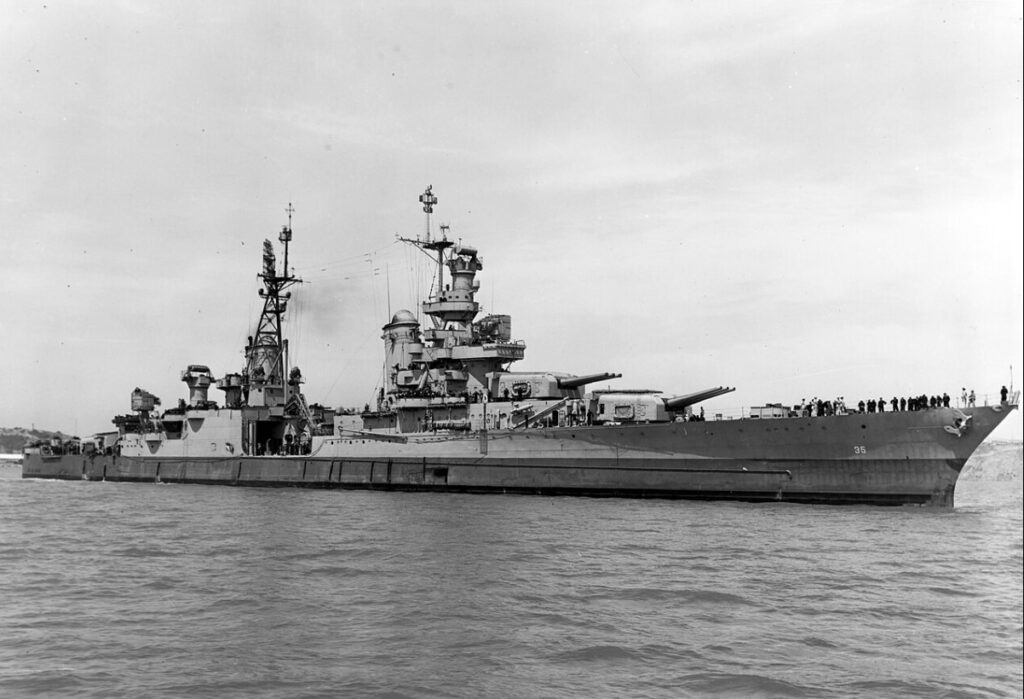It’s the 50th anniversary of the 1975 blockbuster movie Jaws. Not long after seeing the movie I went to the beach for a swim and the shark attack music kept playing in my head as I sheepishly looked around the ocean for a dorsal fin and thought, “now you’re being silly.” But one scene in the movie was based on a true story. In the scene Quint, a professional shark hunter, tells the story that on July 30, 1945, toward the end of WWII the U.S. Navy’s heavy cruiser, USS Indianapolis, was sunk by a Japanese submarine. After the ship sank many of the crew died from shark attack.

Flagship of the 5th Fleet, the USS Indianapolis served with honor from Pearl Harbor through the last campaign of World War II, including the battles at Saipan, Guam, the Battle of the Philippine Sea, Iwo Jima, and Okinawa. The ship earned ten battle stars. On her last voyage the Indianapolis was returning from a secret mission delivering components for the atomic bomb nicknamed “Little Boy” to the island of Tinian. This was the A-bomb that was later dropped on Hiroshima.
It was during the return from this secret mission that the Indianapolis was steaming unescorted at a speed of 17 knots toward a rendezvous with the U.S. fleet when she was struck by 2 Japanese torpedoes fired from the submarine I-58. The first torpedo struck her bow while the second hit amidships near the powder magazine. The explosion almost split the ship in half causing her to capsize and sink in 12 minutes.
Of the 1,195 crewmen aboard 300 went down with the ship and 890 sailors went into the water. The stranded sailors, many wounded and without life jackets, drifted in the open ocean facing exposure, dehydration, saltwater poisoning, and shark attacks. After four days and five nights, the survivors were sighted by a U.S. Navy aircraft on routine patrol. The pilot radioed the report of “many men in the water,” and alerted a PBY flying boat. The destroyer, USS Cecil Doyle, arrived on scene and began rescue operations.
Of the 890 men that went into the water only 316 survived to be rescued. Although the exact number is not known it is estimated that at least 150 seaman were killed by sharks. Most of the attacks were by oceanic whitetip sharks. These large predators, growing up to 13 feet in length, are considered one of the most dangerous species of sharks. They are known for their feeding frenzies and aggression towards shipwreck survivors.
The sinking of the Indianapolis and its aftermath are still surrounded by controversy, particularly the court-martial of the captain, Charles Butler McVay III. A 1920 graduate of the U.S. Naval Academy and a highly decorated officer whose medals included silver and bronze stars for bravery. McVay was put on trial and convicted of failing to zigzag. He is the only naval officer ever to be court-martialed by losing a ship by an act of war.
Because the Indianapolis was on a secret mission and was maintaining radio silence McVay didn’t receive crucial intelligence, that a Japanese submarine was operating in the area. Only a short time before, the U.S. destroyer Underhill was sunk by a Japanese sub in the area. This information was also not disclosed at the time of his court-martial.
It came out during the testimony that McVay had requested a destroyer escort for the Indianapolis, but his request was denied even though the Indianapolis had no submarine detection equipment. Why the Navy would make such an incredibly poor decision with such a valuable ship is beyond understanding. The Navy left McVay and the Indianapolis sitting ducks.
The Navy also claimed that no SOS messages were ever received. Later declassified records showed that three SOS messages were received but none were acted upon. In one case the commander was drunk, in another the officer thought the message was a Japanese hoax, and in the last case the commander had given orders not to be disturbed.
McVay’s conviction effectively ended his career as he lost seniority. The sentence was eventually overturned by Secretary James Forrestal owing to McVay’s bravery and he was finally promoted to rear-admiral when he retired in 1949.
Captain McVay never got over his court-martial by the Navy to cover up its own mistakes. Many of the men who served under McVay thought the Navy had made him the fall guy. Unfortunately, some of the dead men’s grief-stricken relatives blamed McVay for their deaths and he struggled throughout his life with the impact of their letters and phone calls. After years of mental health problems and the death of his wife Captain McVay tragically took his own life in 1968.
Today it is generally recognized by U.S. Naval experts that Captain McVay’s conviction, although legally sound was morally wrong. Holding him solely caused trauma and moral injury to him, his family, and to his men and their families. He was finally posthumously exonerated by the 106th Congress and President Bill Clinton on October 30, 2000.
On December 20, 2018, the crew of Indianapolis was awarded a Congressional Gold Medal, our country’s oldest and highest civilian award. Harold Bray, 98 years old, is the only USS Indianapolis survivor still alive as of September 2025. He continues to honor his shipmates and their story by speaking about the tragedy and the importance of courage, sacrifice, and survival.
